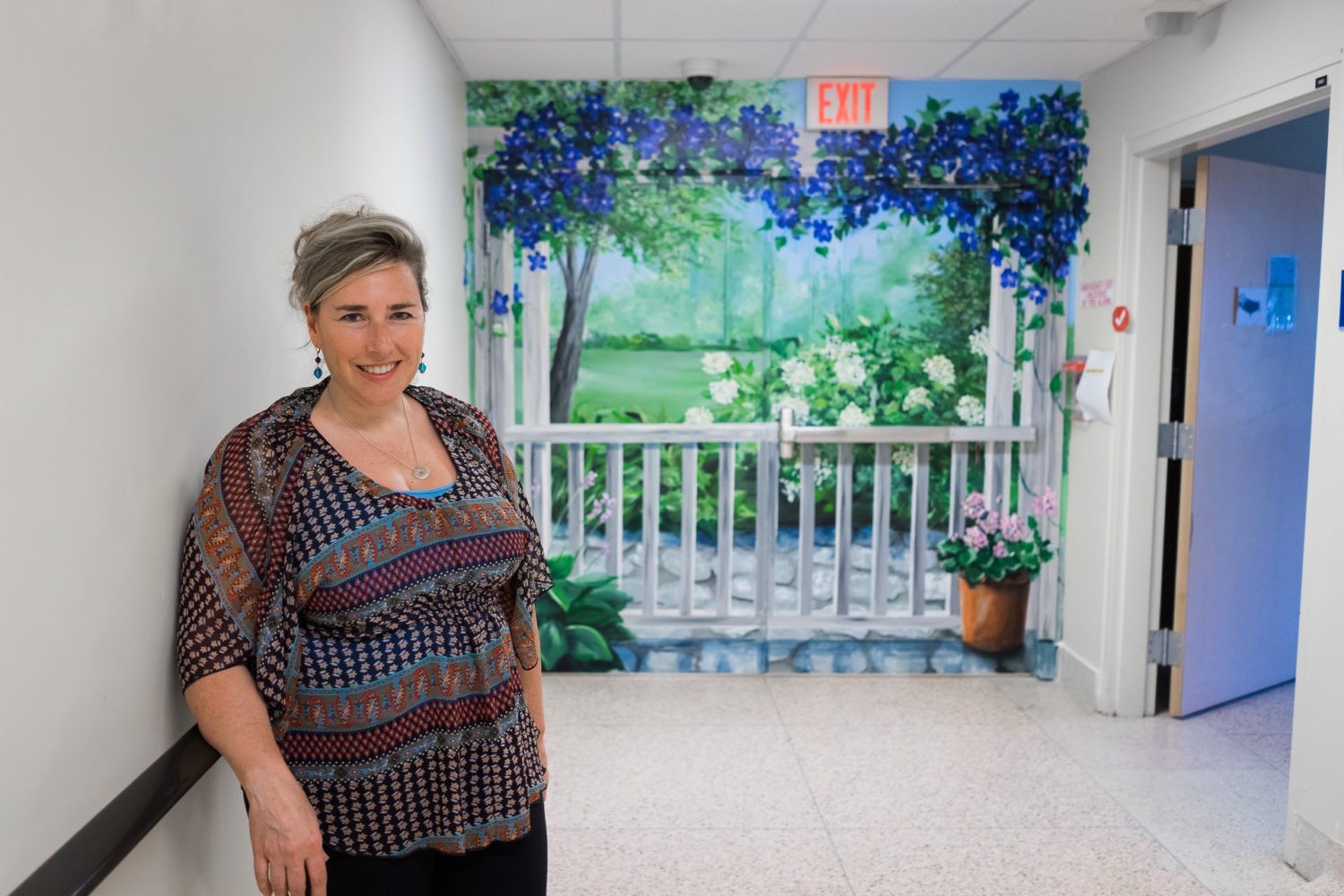“Eighteen years ago, I started painting murals. A designer called me for a mural project at a long-term care facility. I had never worked in any kind of health care before that. This facility is largely Italian. When you came in, there was a great big entrance area and it was, I guess, very institutional so they wanted to make it a look like a piazza. With paint.”
“Nicole, who was running the senior’s department at this hospital, had seen my work at that long term care facility. She was looking for some funding to do similar work in the seniors mental health area here. The walls were so barren and they thought my work would help to stimulate patients.”
When I came to the ward for the first meeting that we had, it was so bleak and dismal! But at the same time the walls are like massive huge blank canvases.

“They had two exit doors that patients with dementia were constantly trying to exit through. It’s not so much that they wanted to go home. It’s more the fact that they see a door and they want to go through the door. It’s just an automatic response.”
“The wheels started turning. We decided the doors in the seniors’ mental health area would be sort of a garden. It’s just a very enclosed, dismal space and so I wanted to bring the outside in and I wanted features that are calming.”
“The effect I saw was immediate! With the first door the very first day, I was trying to prime and tape and there was a lady, Betty, that kept coming down with her walker and she kept saying ‘oh I want to get out, let me past, let me get out, let me get out…’ And within, within two days as the mural formed on the door, she would come down to the end of the hall and she would look at it and then she would turn around and go back the other way. By the time it was finished, she didn’t even come down the hall anymore. She’d stand and look at the painting. And then she would go elsewhere.”
“People said, ‘it’s such a relief there is no more banging on the wall, no more banging on the door. It really does work.'”
There was much less distress. Less exit-seeking.

“I suggested we get the seniors involved in the painting. I left a section in the middle that’s flora and leaves so that they could literally just dab paint. Then afterwards I touched it up. Some really gravitate towards it and some are not interested at all.”
That creative instinct is still there in some people.

“I put in many 12, 13…16, hours days so it’s not an easy way to make a living, but this has been very gratifying because of the response of the patients.”
“On a psychiatric ward where I was painting, there was a young guy. He said he had been coming in and out of mental health since he was 16. He told me ‘this is the first time I’ve actually not minded being here because there’s something to look at it and it’s beautiful.’”
“I had another young guy ask me what a forest scene I was painting meant. And I thought okay, it’s a forest but I am not quite sure what it means beyond that. He said ‘to me what it means is the forest is the darkness and that’s your illness, and when you are coming into the clearing that’s where the sunshine is. That’s your treatment, that’s you getting better.’”
People aren’t just appreciating the paintings aesthetically but they find some kind of therapeutic meaning in them.

“I thought no wonder they need things on the walls because literally the patients walk up and down the halls all day.”
“This surprised me because my experience in health care up to that point had been a private long-term care facility that was primarily seniors and there were a lot of activities planned. Bingo, painting sessions, music therapy. Here on the psychiatric ward, they often just wait for their time to go out for the smoke break. They are allotted two cigarettes and a lighter to go out on their smoke break if they have privileges.”
It’s like they are dying to just do something.

“As an artist it’s always amazing to me how many people don’t validate what I’m doing and they think art should be something that’s donated.”
I did actually have a doctor stop me at 11:00 at night ask if I had a real job in the day. I said I started here at 9:00 this morning, this is my real job!

“Both of my parents went through cancer. My brother was run over by a boat and very badly injured. I used to think my kids had spent more time at the hospital than anywhere else. I look back and I don’t know how we got through all of that. I remember with both my parents sitting through chemotherapy all day long and you’re just literally staring at the walls.”
“It’s interesting when we bring people in here (the hospital), we give them nothing else to think about but their illness. There are so many things that can be the thing that sparks something in somebody and you just don’t know what it is.”
To limit care to medication and not invest in other things cuts down people’s chances of finding coping mechanisms or finding ways to bring something to their own lives.


The comments section is closed.